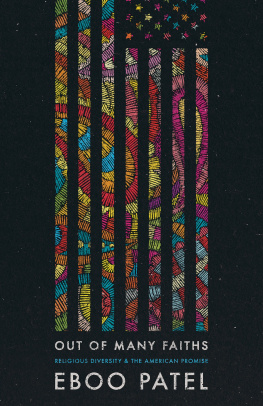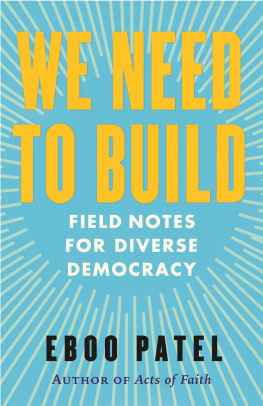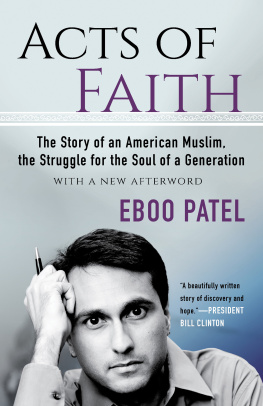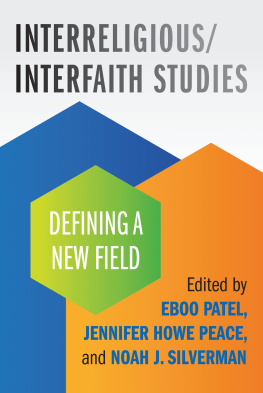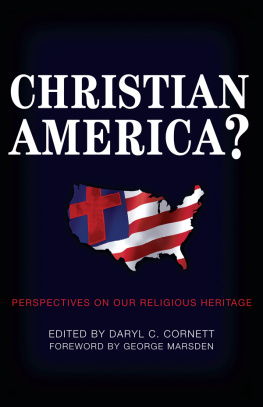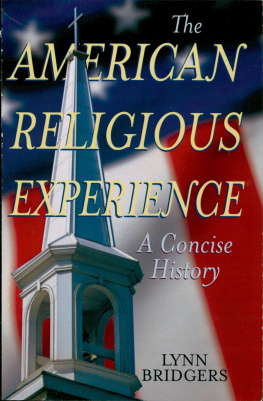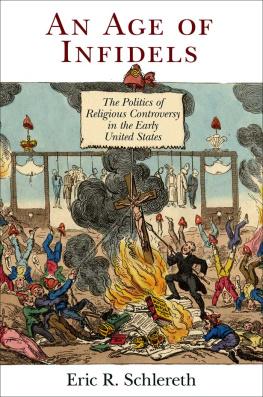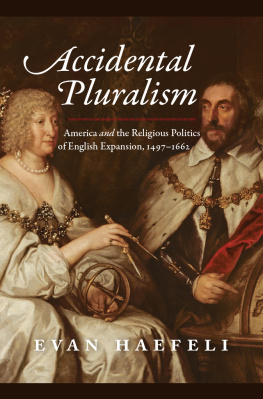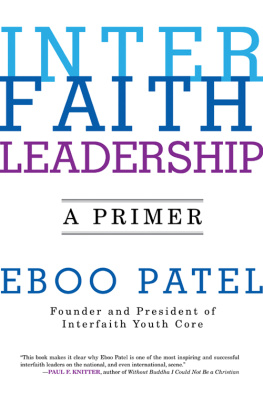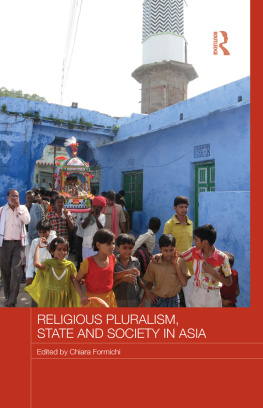Earl Lewis and Nancy Cantor, Series Editors
Other books in this series:
Scott E. Page,
The Diversity Bonus: How Great Teams Pay Off in the Knowledge Economy
Earl Lewis and Nancy Cantor, editors,
Our Compelling Interests: The Value of Diversity for Democracy and a Prosperous Society
Out of Many Faiths
Religious Diversity and the American Promise
Eboo Patel
PRINCETON UNIVERSITY PRESS
Princeton and Oxford
Copyright 2018 by Princeton University Press
Requests for permission to reproduce material from this work should be sent to
Published by Princeton University Press
41 William Street, Princeton, New Jersey 08540
6 Oxford Street, Woodstock, Oxfordshire OX20 1TR
press.princeton.edu
All Rights Reserved
Library of Congress Control Number: 2018943925
ISBN 978-0-691-18272-8
British Library Cataloging-in-Publication Data is available
Editorial: Eric Crahan and Pamela Weidman
Production Editorial: Karen Carter
Jacket Design: Faceout Studio, Derek Thornton
Jacket Art: Courtesy of Shutterstock
Production: Jacqueline Poirier
Publicity: Julia Haav
Copyeditor: Ashley Moore
This book has been composed in Arno and Futura
Printed on acid-free paper.
Printed in the United States of America
10 9 8 7 6 5 4 3 2 1
There is but one destinyleft for us, and that is to make ourselves, and be made by others a part of the American people in every sense of the word.
FREDERICK DOUGLASS
Contents
Earl Lewis and Nancy Cantor
Robert P. Jones
John Inazu
Laurie L. Patton
Acknowledgments
In the spring of 2016, I received a surprise phone call from my friend Nancy Cantor, Chancellor of Rutgers University in Newark. She and Earl Lewis were co-editors of an important new book series about diversity in American life called Our Compelling Interests, and they wanted me to be the principal author of the volume on religion.
Nancy, I just finished a book, I said. Im not sure I have the energy to start another one right away.
The series is a partnership between the Andrew Mellon Foundation and Princeton University Press, and we believe it can play a critical role in helping America positively engage the challenges and opportunities of our growing diversity.
How was I going to say no to that?
Im enormously grateful to Nancy and Earl for electing to include a volume on religion in a series on diversity (its a category that is too often ignored in identity conversations), and for selecting me to be the principal author. Im also grateful to the authors of the three excellent commentaries included in the volume: Robert Jones, John Inazu, and Laurie Patton.
I truly enjoyed working with Doreen Tinajero and Makeba Morgan Hill at the Mellon Foundation. The entire Our Compelling Interests series relies on their excellent behind-the-scenes work. The staff of the Mellon Foundation and the Advisory Board for the series made useful comments on the manuscript. Many thanks to them. Similar gratitude is due the staff at Princeton University Press, particularly Eric Crahan.
Special thanks to several American Muslim friends who read and offered comments on the sections about our faith community: Alia Bilal, Haroon Mogul, Kashif Shaikh, Jenan Mohajir, Rami Nashashibi, and Zeenat Rahman. I am proud to be building American Islam with you.
A big thank you to the board and staff at Interfaith Youth Core, who gave me the time and space to work on this book amid a full-to-bursting program schedule. Special thanks to Mesha Arant and Teri Simon at IFYC, who helped with research, editing, and preparing the manuscript for publication.
And finally, to my wonderful familyparents and brother, wife and kidswho encourage me even when it goes against some of their most compelling interests. As my wife Shehnaz wisely notes, Yes, youre moody when youre writing a book, but youre worse when youve got a book in your head that youre not writing.
Introduction
Earl Lewis and Nancy Cantor
Every Mothers Day at the New Jersey Performing Arts Center in Newark, New Jersey, the Alvin Ailey Dance Company performs Revelations to a packed audience of families, from children to senior citizens, as diverse a crowd as one can conjurepeoples of all hues, heritages, faiths, dress, and languages. Strongly identified with the particulars of the Christian spiritual tradition, the dance invoked a message that moved members of multiple faith traditions. There are universal elements to the story. There are those who see in it an affirmation of a particular struggle for civil rights, and those who identify with it from a less personally direct lineage but find its call to humanity and the human spirit compelling nonetheless. It feels like America at its best, and the moment is decidedly strengthened by the variety of personal histories in the room, as it is also by the commonality of the experience of uplift. There is always a loud and resoundingly prolonged standing ovation, as the audience holds out the hope that the moment of collective affirmation will last. Indeed, those are the moments that we want to last, in which diversity contributes powerfully to the strength of community. And although it surely isnt only a day a year that this is evident, it does seem that there are precious few demonstrations these days of what some might say is the distinctly American ethos, E pluribus unum .
The Fraying ofE pluribus unumand the Bonds of Empathetic Citizenship
Arguably, we live in a time comparable to many of the most strained periods in our national history. It is a time when the human bonds of empathetic citizenshipthe openness to see value in others different from oneself and the concomitant responsibility for bridging those differences to create an interdependent wholeare deeply frayed. This fraying of the bonds of citizenship imperils the fabric of democracy itself, as we have seen from sea to shining sea. Who, after all, would have predicted that in the twenty-first century the signs, symbols, and rhetoric of the Nazi era would be on public display in crowds marching on a college campus in Charlottesville, Virginia, chanting, Jews wont replace us and Blood and soil? What do we say when nooses appear overnight on the National Mall in Washington, DC, directed especially at the Smithsonians National Museum of African American History and Culture?
Where do we situate religion in this recurring clash of visions? Have we regressed to another bleak period of our national history, when we created Japanese American internment camps on our own soil in reaction to the bombing of Pearl Harbor? Following that playbook, will we lock up Muslim Americans, our neighbors in cities and towns across America, painting all with the brush of a threat from violent extremism? How do we reconcile the reluctance to label some violent acts of hate committed by white Christians (adhering to supremacist ideology) as domestic terrorism, on the one hand, with the speed with which we make that connection to hateful acts committed by other citizens but in the name of Islam, on the other? Have we moved on so little from our racist, xenophobic, and religiously exclusionary past and progressed so little in expanding the narrative of who is American, even as the facts of our diversity become more pronounced and our aspirations for pluralism march resoundingly forward?

